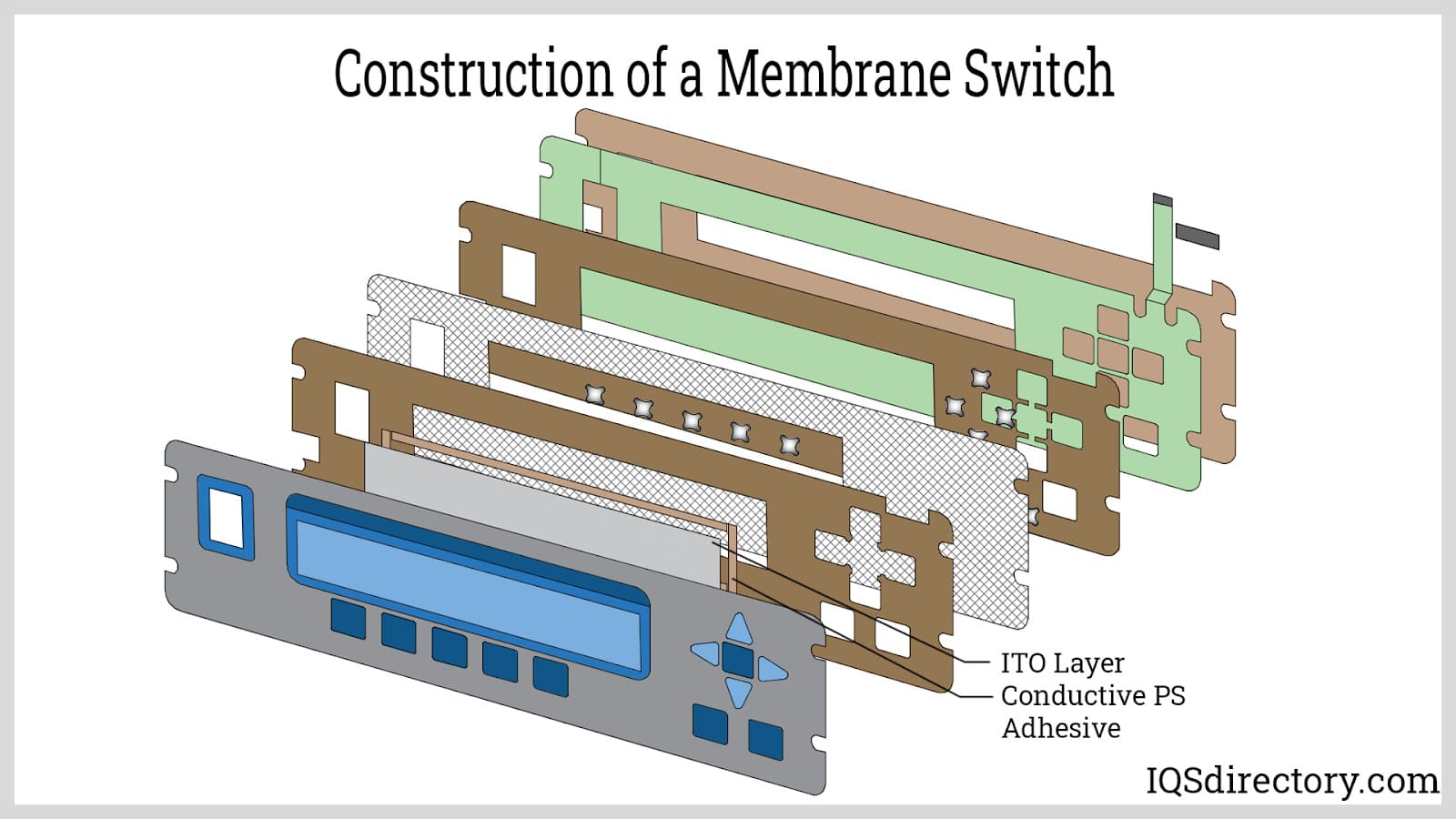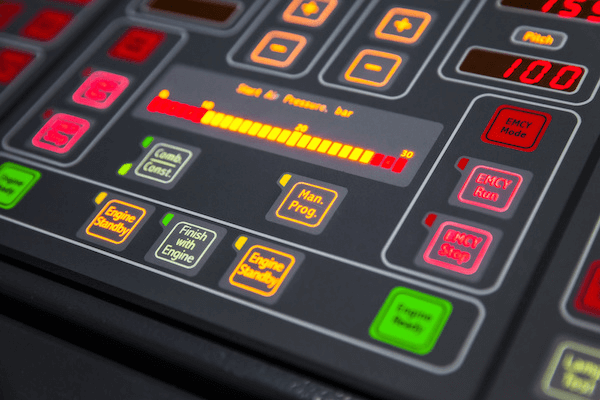The Production Refine Behind Membrane Layer Switch Over: What You Need to Know
The production process behind membrane switches combines careful style, product option, and quality assurance. It starts with understanding the ins and outs of membrane layer button layout and advances with various stages, consisting of material options and printing techniques. Each stage plays a necessary role in making certain functionality and sturdiness. Nevertheless, the complexities of layer building and construction and the rigorous testing criteria may reveal understandings that are not promptly evident. What lies beyond these fundamental elements?
Understanding Membrane Layer Switch Layout
Although membrane switches may appear straightforward in the beginning glimpse, their design entails elaborate factors to consider that assure capability and resilience. The design process starts with a thorough understanding of individual demands, consisting of the user interface's designated application and environmental elements. Ergonomics is a crucial element, as the layout needs to help with ease of use while making certain that responsive comments fulfills customer expectations.Moreover, the layering of parts, such as visuals overlays, glue layers, and conductive traces, have to be specifically crafted. membrane switch. This layered arrangement not just influences the button's responsiveness however additionally influences its long life. Focus is provided to the sealing techniques utilized to shield versus wetness and dirt, which could compromise efficiency. In addition, design factors to consider include looks, where color design and visual clearness improve individual experience. Eventually, the design of membrane switches balances capability, user experience, and resilience, guaranteeing that they meet the demands of different applications effectively
Products Made Use Of in Membrane Layer Switch Over Manufacturing
When selecting materials for membrane switch manufacturing, it is important to contemplate both efficiency and durability. The key products consist of polyester and polycarbonate movies, which give flexibility and toughness. These films are typically covered with adhesive to guarantee proper bonding to substrates. Conductive inks, generally made up of silver or carbon, are critical for developing electrical connections within the button, permitting for reliable operation.Additionally, a protective layer, such as a tough layer, is often related to boost scratch resistance and longevity. The option of backing product, such as acrylic or foam, can substantially impact the button's tactile feeling and total customer experience. Moreover, numerous environmental elements, including temperature level and humidity, must direct product option to ensure peak performance in certain applications. Inevitably, the ideal combination of products adds to the membrane button's functionality and life-span, making informed selections vital for manufacturers.
The Printing Process: Creating Video and Text
The printing process in membrane layer switch production plays a considerable function in producing premium graphics and message. Numerous graphic layout strategies are utilized to assure aesthetic allure and functionality, while cautious ink choice techniques are important for toughness and efficiency. Understanding these aspects is essential for attaining finest lead to membrane layer button style.
Graphic Layout Techniques
Graphic layout methods play an important function in the printing process of membrane layer buttons, as they define just how graphics and text will inevitably show up on the last product. Efficient visuals design includes the critical use font styles, colors, and formats to boost readability and aesthetic appeal. Developers frequently utilize vector graphics for scalability, guaranteeing that photos continue to be sharp at different sizes. Furthermore, interest to comparison and alignment is crucial, as it influences user interaction and aesthetic top quality. The consolidation of branding components, such as logos, must be handled with treatment to maintain brand honesty. Overall, thoughtful visuals layout techniques contribute substantially to the performance and attractiveness of membrane layer switches, influencing customer experience and item efficiency.
Ink Option Methods
Choosing the appropriate ink is necessary for attaining the preferred aesthetic high quality and toughness in membrane layer switch production. Different ink kinds are utilized, consisting of solvent-based, water-based, and UV-curable inks. Each kind offers unique features, such as resistance, attachment, and flexibility to environmental variables. Solvent-based inks are usually preferred for their longevity and dynamic shades, while water-based inks are much more ecologically pleasant however might have constraints in bond. UV-curable inks supply fast curing and durable performance. Additionally, shade matching strategies guarantee that the selected inks align with layout requirements. Ultimately, the choice of ink must think about aspects such as application method, substratum compatibility, and end-use requirements to achieve exceptional lead to membrane layer button graphics and message.
Layer Building And Construction and Assembly

Product Option Refine
A careful choice of products is crucial in the production procedure of membrane switches, as it straight influences performance and longevity. The key materials used consist of polyester, polycarbonate, and different conductive inks. Polyester is often favored for its excellent resistance to chemicals and abrasion, making it appropriate for severe environments. Polycarbonate, on the other hand, offers superior clearness and impact resistance, which is advantageous for applications needing visibility and toughness. Conductive site here inks, generally composed of silver or carbon, are vital for creating trustworthy electric pathways. Additionally, the option of adhesive products influences the total honesty of the switch - membrane switch. Assessing variables such as environmental direct exposure, responsive responses, and aesthetic needs overviews producers in choosing the best products for their certain applications
Layer Attachment Methods
Sticking layers in membrane switch building and construction is a vital procedure that guarantees performance and longevity. Numerous attachment strategies are employed to safeguard ideal bonding in between layers, which generally consist of using adhesives, warmth, and stress. Pressure-sensitive adhesives (PSAs) are typically used for their ease of application and instant bonding abilities. Furthermore, thermal bonding techniques can be applied, where warm is utilized to turn on glue residential or commercial properties, safeguarding a solid bond. The selection of bond approach mostly depends upon the products involved and the specific application needs of the membrane layer switch. Correct alignment and consistent application of adhesives are vital to stop flaws, securing the switch operates efficiently throughout its designated life expectancy.
Quality Assurance Procedures
Assuring quality assurance throughout the layer building and construction and setting up of membrane buttons is vital for maintaining performance and reliability. This process usually includes a number of important procedures, consisting of comprehensive inspections at each phase of production. Producers use sophisticated screening techniques, such as peel examinations and attachment evaluations, to verify the honesty of layer bonds. In addition, aesthetic inspections are conducted to recognize any flaws in printing or product inconsistencies. Environmental conditions, such as temperature and humidity, are thoroughly kept an eye on to ensure optimal healing and attachment. Furthermore, routine calibration of devices helps keep accurate manufacturing criteria. By carrying out these quality assurance steps, suppliers can greatly reduce the threat of product failure, assuring that the last membrane layer switches fulfill the called for requirements and customer assumptions.
Evaluating and Top Quality Control Steps

Advancements in Membrane Layer Switch Over Innovation
As improvements in technology remain to evolve, membrane layer switches are taking advantage of ingenious advancements that enhance their functionality and user experience. One remarkable development is the integration of capacitive touch technology, which enables more user-friendly and responsive interface. This shift not just boosts aesthetic appeals yet also reduces mechanical wear and tear, prolonging the life expectancy of the switches.Additionally, developments in graphic overlay products have actually resulted in boosted resilience and resistance to ecological variables such as dampness and UV light. These materials now provide enhanced quality and illumination, more boosting the visual appeal.Furthermore, the consolidation of clever innovation is changing membrane layer changes right into interactive control board, enabling connection with IoT tools. This connectivity promotes a smooth customer experience, paving the method for applications in numerous industries, from health care to customer electronic devices. Collectively, these developments placement membrane layer switches as important parts in modern device style.
Regularly Asked Inquiries
For how long Does the Membrane Change Production Refine Take?
The period of the membrane layer button manufacturing process can vary considerably. Elements such as intricacy, products utilized, and manufacturing quantity impact timelines, with typical production ranging from a few days to a number of weeks for completion.
What Are the Typical Applications for Membrane Switches?
Membrane switches are typically used in different markets, including vehicle controls, family home appliances, clinical gadgets, and consumer electronics (membrane switch). Their flexibility and toughness make them suitable for applications needing easy to use interfaces and reputable performance in diverse settings
Can Membrane Layer Changes Be Personalized for Particular Needs?

What Is the Life expectancy of a Regular Membrane Layer Switch?
The life expectancy of a regular membrane here are the findings layer switch varies, however normally, it varies from 1 to 5 million cycles. Variables such as use, environment, and material quality considerably affect longevity and total performance in time.

Are Membrane Layer Switches Over Eco-friendly?
The ecological friendliness of membrane switches varies. Some materials made use of might not be recyclable, while others can be green. The total effect depends upon producing practices and materials, requiring cautious consideration throughout option and disposal. The production process behind membrane switches over combines cautious style, material option, and high quality control. It begins with understanding the details of membrane layer switch design and proceeds with various phases, including click to find out more material selections and printing methods. When selecting products for membrane button production, it is important to contemplate both efficiency and sturdiness. A careful option of materials is crucial in the production process of membrane layer switches, as it straight influences capability and sturdiness. The choice of bond method mainly depends on the materials entailed and the particular application needs of the membrane button.